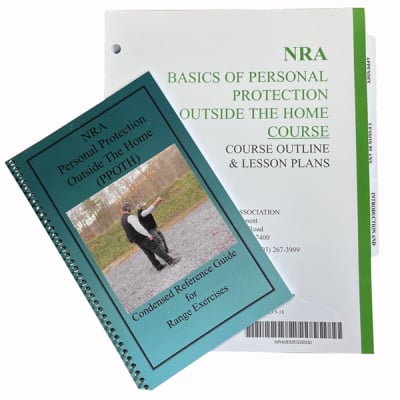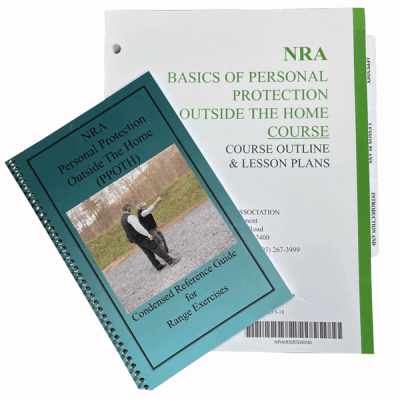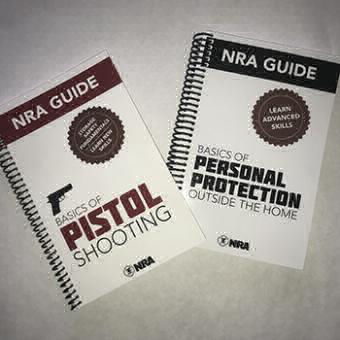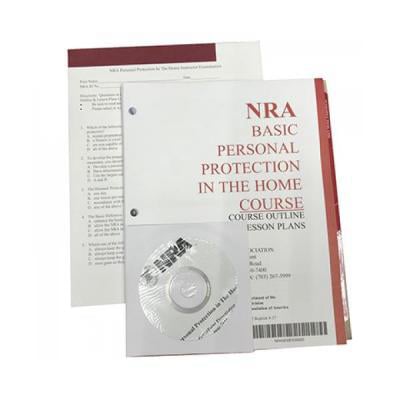NRA Basic Personal Protection Inside the Home Instructor Course
To qualify as an NRA Instructor:
Short Description:
This 15-hour course teaches the knowledge, skills and attitude essential to organizing, promoting and teaching the NRA Basic Personal Protection In The Home course.
More Details:
Prerequisites: Must be an NRA Certified Pistol Instructor. Prior to the course, candidates complete a pre-course questionnaire and demonstrate their firearm background in pre-course assessment exercises.
Description: Course is presented in two parts: basic instructor training and discipline specific instructor training. Students demonstrate organizational and teaching skills via participation in practical exercises during the course, and complete an instructor certification examination. Students will receive the NRA Trainer’s Guide, NRA Basic Personal Protection In The Home Instructor Candidate Packet and NRA Basic Personal Protection In The Home course student packet.

NRA Basics of Personal Protection Outside the Home Instructor Course
To qualify as an NRA Instructor:
Short Description:
Teaches students the knowledge, skills and attitude essential for avoiding dangerous confrontations and for the safe, effective and responsible use of a concealed pistol for self-defense outside the home.
More Details:
Prerequisite: This course is for adult individuals who are not disqualified from possessing a firearm as defined by applicable federal, state, or local law and are of good repute and possess defensive pistol skills presented in the NRA Basics of Personal Protection In The Home Course. Participants must also understand the basic legal concepts relating to the use of firearms in self-defense, and must know and observe not only general gun safety rules, but also those safety principles that are specific to defensive situations. Prospective participants can demonstrate that they have the requisite knowledge, skills, and attitudes by producing an NRA Basic Personal Protection In The Home Course Certificate, or by passing the pre-course evaluation. Description: The course is divided into two levels. Level one is nine-hours and offers the essential knowledge and skills that must be mastered in order to carry, store, and use a firearm safely and effectively for personal protection outside the home. Students spend several hours on the range and shoot approximately 100 rounds of ammunition during level one. Upon completion, students may choose to attend level two, which is an additional five hours on the range and approximately 115 rounds of ammunition learning advanced shooting skills. Time and ammunition requirements are minimum, and may be exceeded. Students will receive the NRA Guide to the Basics of Personal Protection Outside The Home handbook, NRA Gun Safety Rules brochure and appropriate (level one/level two) course completion certificates(s)
Note: Lesson III: Firearms and the Law, and Legal Aspects of Self-Defense, of the Personal Protection In and Outside The Home Courses is conducted by an attorney licensed to practice law within the state in which this course is given and who is familiar with this area of the law, a Law Enforcement Officer (LEO) who possesses an intermediate or higher Peace Officer Standards and Training (POST) certificate granted within the state, or an individual currently certified to instruct in this area of the law by the state in which this course is presented.
NRA Certified Instructors may conduct this lesson only if they meet the requirements stated above and then only in their capacity as an attorney, or other state certified individual, not in their capacity as an NRA Certified Instructor.

NRA Defensive Pistol Course
To qualify as an NRA Instructor:
Short Description:
Teaches the knowledge, skills, and attitude to carry and use a concealed pistol ethically, responsibly, and with confidence.
More Details:
The NRA Defensive Pistol Course will focus on the techniques needed to develop a defensive mindset. The goal of the course will be to develop the knowledge, skills, and attitude necessary to carry and use a concealed pistol ethically, responsibly, and with confidence. As a result of participating in this course, the student will be able to explain and demonstrate the following: How to apply the NRA Rules for Safe Gun Handling when carrying a concealed firearm, basic principles of concealment, the difference between cover and concealment, drawing from the holster, levels of mental awareness, developing the proper mindset when using a pistol for personal protection, clearing common stoppages, use of pocket pistols, and more. Students will receive the NRA Guide to the Basics of Personal Protection Outside The Home handbook, NRA Gun Safety Rules brochure and the NRA Defensive Pistol certificate.
This course is only conducted by NRA Certified Advanced Pistol Instructors.

NRA CCW Instructor Course
To qualify as an NRA Instructor:
Candidates must have completed the basic course in the discipline they wish to be certified to teach, e.g. NRA CCW. NRA Basics of Pistol Shooting, NRA Basic Rifle Shooting, etc.
Candidates must possess and demonstrate a solid background in firearm safety and shooting skills acquired through previous firearm training and/or previous shooting experience. Instructor candidates must be intimately familiar with each action type in the discipline for which they wish to be certified.
Candidates will be required to demonstrate solid and safe firearm handling skills required to be successful during an instructor training course by completing pre-course questionnaires and qualification exercises administered by the NRA Certified Training Counselor.
Candidates must satisfactorily complete an NRA Instructor Training Course in the discipline they wish to teach (e.g., NRA Basic Pistol Course), and receive the endorsement of the NRA Training Counselor conducting that training.
NRA Instructor courses are discipline specific. During the course candidates will learn NRA policies and procedures; basic public speaking skills; training methodology; use of a training team and training aids; organizing a course, building a budget; and finally preparing to teach. In addition, candidates will be provided the appropriate lesson plans and basic course student packets. Role-playing is a major part of an instructor course; therefore, the minimum class size should be at least four candidates, with 10-12 candidates being ideal. Candidates take turns working in teams, actually conducting portions of the course to other candidates who portray basic students.
